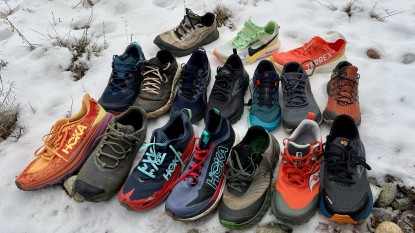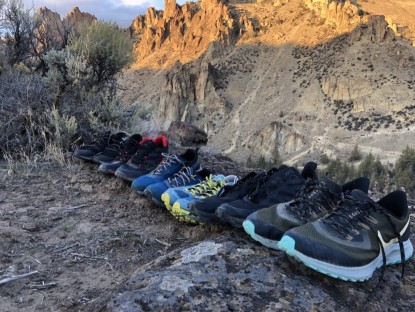Saucony Peregrine 11 Review
Our Verdict
Our Analysis and Test Results
The Saucony Peregrine 11 makes minor tweaks to the previous version, resulting in a similar feeling and performing update. The main observable changes include an additional set of lace eyelets, a smaller (but still effective) toe bumper, and the removal of some of the plastic overlays on the uppers. The latest Perigines are as versatile and comfortable as their predecessors. In an industry that constantly shelves or drastically alters our favorite models on a seasonal basis, we're happy to see the best design features sticking around for a while. If you like the Peregrine's feel and performance, a few other versions are available depending on your needs. These include a Gore-tex version, a wide-fitting model, and the deeper lugged, quick lacing “ST” version.
Foot Protection
Compared to many modern trail shoes, the Peregrine 11 has heavily padded uppers. The tongue is thick and plush, excellent for protection, and distributes pressure more evenly when you crank down the laces. Even the “mesh” upper is tougher than the standard mesh from competitors like Salomon or Inov-8. While it isn't as breathable, it will not shred from a stick or rock puncture.
From down below, the PWRRUN midsole provides plenty of cushioning, with a stack height of 27mm and 23mm in the heel and forefoot, respectively. If you look closely, you can actually see the rock plate through the tiny drainage holes in the sole. The rock plate is constructed from tightly woven nylon, allowing for more flexibility than a piece of plastic. We feel this shoe is adequately protective between the midsole and the rock plate, sacrificing overall sensitivity. For folks who've cut their teeth frolicking through scree fields and boulder hopping, the Peregrine will do the trick, and folks making the transition from pavement to the great wide open will appreciate the level of protection.
Traction
Saucony's PWRTRAC outsole does an admirable job of striking a balance between grip and durability. It's soft enough to grip rocks slabs but not so soft that the rubber breaks down quickly or the lugs tear off. The 4mm lugs kept us on our feet and feeling confident when we were pounding down gravely single track. 4mm is a nice sweet spot, establishing good traction in gravel without caking on too much mud in wetter conditions, though sometimes this is unavoidable. Overall, these shoes earned a higher than average score in this metric, almost on par with the Salomon Speedcross 5
Little seems to have changed in the outsole from the previous version. Still present are the spots for drilling screw inserts for added traction on ice and snow, as are the points in the middle of the sole for drilling drainage holes. (Of course, you could always pick up a pair of top-rated snow grips if you need extra traction for any running shoe.) We didn't test these features, as Saucony offers no instructions, and we had no ice to run on at the time of testing. One of our testers has experience modifying other trail shoes in this way and claims it is the way to maintain a high mileage every week, despite snow and ice. He also admits this reduces the shoe's lifespan, as once there are holes, they can't be undone. However, the Peregrine is affordable, so they're a good candidate for a “winter only” modified shoe if you so desire.
Sensitivity
We are surprised to find that these shoes are impressively sensitive, even though they are reasonably protective. They earned one of the highest scores in the group. Someone new to trail running will appreciate the responsiveness to uneven terrain underfoot while still getting plenty of protection from roots and scree.
We attribute this to the woven nylon rock plate, which is very flexible. For folks new to trail running, the Peregrine 11 will feel more like a traditional running shoe for pavement but still provide some trail feedback.
Stability
Like its predecessor, this is a very stable shoe, earning top marks alongside contenders like the Inov-8 Terraultra G 270 and the Nike Air Zoom Terra Kiger 7. After cranking down the laces, we didn't feel any slippage or instability when charging uneven terrain. The heel stays locked in place, without the shoe feeling particularly narrow.
With 4mm of drop, the whole package feels delightfully neutral, and while 23mm under the forefoot doesn't feel like a racing flat, the Peregrine 11 feels more stable than higher stacked competitors. The stability pays off at the end of a long day when our form starts to suffer, and we're more prone to missteps and stumbles that could lead to injury.
Comfort
The Peregrine 11 feels true to fit, with a little extra room at the end of the toe. It doesn't feel particularly wide, but we still feel like there's a little room for swollen feet. This shoe has a Goldilocks toe box that garners praise from multiple testers with varying foot shapes, and it earned an above-average score in this metric. For folks sporting flippers for feet, it's also available in an EE-wide version.
We appreciate the classic lacing design that extends quite a ways towards the front of the foot, allowing for minor adjustments throughout to accommodate a wider variety of foot shapes. Shoes from Altra and Dynafit have comfortable lacing systems that only extend halfway down the foot, but if you don't quite fit in these brands, you're out of luck. People can have similar problems with the quick lacing systems on Salomon shoes. While the more traditional lacing style of the Peregrines might require a little finagling initially, a perfect fit will pay off after miles on your feet.
Weight
Tipping our scale at 22.5 oz for a US 9.5, these shoes aren't anywhere near the lightest we've tested. They feel surprisingly light and nimble, though. Even compared to some more lightweight models, they don't feel clunky and keep our testers bouncing along without dragging their feet.
Should You Buy the Saucony Peregrine 11?
Season after season, regardless of material and design changes, the Peregrine remains an affordably priced trail shoe that makes getting off the pavement and out into the woods accessible for more folks. They also accommodate a variety of foot shapes and are reasonably durable to boot, so they're an excellent value. They're a perfect option for anyone breaking into trail running or veteran crushers looking to log miles in a sensitive, protective shoe.
What Other Trail Running Shoes Should You Consider?
We're happy to report that the slight changes made from the previous Peregrine translate to an even better shoe and a good value to boot. However, we don't consider it a “crossover” shoe and recommend sticking primarily to the trails while choosing a road running model for those punishing miles spent on the pavement. If you are more of a “quiver of one” kind of runner, and you don't need a different shoe for every adventure, you may want to look at the Hoka Challenger ATR 6 or the Scarpa Spin Ultra.











